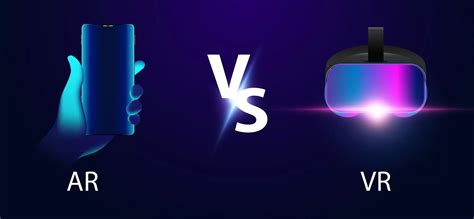

In Front 2025: The Battle of AR vs. VR
Introduction
The future of immersive technology is being shaped by two cutting-edge advancements: augmented reality (AR) and virtual reality (VR). Both technologies have the potential to revolutionize various industries, but their distinct characteristics set them apart in the race for dominance.

Augmented Reality: The Enhanced World
Augmented reality (AR) superimposes digital information onto the real world, allowing users to interact with virtual objects in their surroundings. By leveraging a smartphone or dedicated device, AR experiences blend the physical and digital realms seamlessly.
Advantages of AR:
- Enhanced Information: AR provides real-time data and contextual information, making it ideal for education, healthcare, and industrial applications.
- Interactive Experiences: Users can interact with digital objects in their environment, creating engaging and interactive experiences.
- Productivity Boost: AR can improve productivity in tasks like assembly, maintenance, and navigation.
Virtual Reality: The Immersive Escape
Virtual reality (VR) creates a fully immersive digital environment that transports users to another world. Head-mounted displays (HMDs) provide a 360-degree view, allowing for complete sensory immersion.
Advantages of VR:
- Immersive Storytelling: VR offers unparalleled opportunities for immersive storytelling, engaging audiences in movies, games, and simulations.
- Training and Simulation: VR creates realistic training environments for professionals in fields such as surgery, aviation, and military operations.
- Therapeutic Applications: VR is being explored for therapeutic purposes, including pain management, anxiety reduction, and PTSD treatment.
The Battle for Supremacy
The competition between AR and VR is not simply a matter of who has the most advanced technology but also about addressing specific customer needs and motivations.
Motivations for AR:
- Accessibility: AR is accessible to a wider audience as it requires only a smartphone or dedicated device.
- Practicality: AR integrates seamlessly into everyday life, enhancing tasks and providing information without significant disruption.
Motivations for VR:
- Immersive Entertainment: VR excels in providing immersive entertainment experiences, such as gaming, movies, and VR theme parks.
- Specialized Training: VR simulations are ideal for specialized training, where realistic and immersive environments are essential.
- Emotional Impact: VR can evoke strong emotions by transporting users into emotionally charged virtual worlds.
The Future of Immersive Technology
Both AR and VR have their unique strengths and use cases. The future of immersive technology lies in complementing each other rather than competing directly. Hybrid experiences that combine elements of both AR and VR are expected to gain prominence.
Hybrid Experiences:
- AR-Enhanced VR: AR can enhance VR experiences by providing contextual information and allowing users to interact with their surroundings while in VR.
- VR-Integrated AR: VR can provide immersive training environments that integrate AR elements for hands-on practice and real-world applications.
Tips and Tricks for Developers
Developers creating immersive experiences should consider the following tips:
- Focus on User Value: Identify the specific value AR or VR can bring to the user experience.
- Emphasize User Control: Allow users to customize and control their immersive experiences.
- Leverage Haptic Feedback: Incorporate haptic feedback to enhance immersion and engagement.
FAQs
- What is the difference between AR and VR?
- AR enhances the real world with digital information, while VR immerses users in a completely digital environment.
- Which technology is better?
- There is no one-size-fits-all answer; AR and VR serve different purposes and target different user needs.
- What are the potential applications of AR and VR?
- AR applications include education, healthcare, manufacturing, and retail. VR applications include gaming, training, and simulations.
- What are the challenges facing AR and VR?
- Challenges include hardware limitations, motion sickness, and the need for specialized content.
- What is the future of immersive technology?
- The future lies in hybrid experiences that combine elements of AR and VR.
- What are the key trends in AR and VR?
- Key trends include the increasing use of cloud-based platforms, 5G connectivity, and AI-driven experiences.










